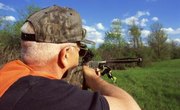
Having a properly adjusted Redfield scope will add greatly to the accuracy of your rifle. Not only will your accuracy improve at ranges generally used for rifles with open sights, but the magnification of the Redfield scope will allow you to make shots hundreds of yards downrange. Whichever Redfield scope you choose, the process will be the same in making it as precise in its function as possible.
Items you will need
Rifle with Redfield Scope
Rifle range
Targets with a one-inch grid pattern
Sandbags
Spotting scope
How to Adjust a Redfield Scope
Go to your local rifle range. Place your unloaded rifle on a bench rest positioned in a safe direction. When it is safe to go downrange, place a target with a one-inch grid pattern at 25 yards. Set up your spotting scope so that you can see your target. (Most rifle ranges rent spotting scopes for a small fee.) Collect a number of small sandbags. Load your rifle. Place the sandbags under the front portion of the rifle stock so you can achieve a comfortable shooting position. Do not let the sandbags touch the rifle barrel. Aim at the center of the target and fire several shots. Look through your spotting scope to see where the shots hit the target. Occasionally, when adjusting new scopes, the bullets will miss the target entirely. If this occurs, aim at each corner of the target until a shot lands on the paper.

sniper rifle on the tripod and optical sight image by Vladimir Melnik from Fotolia.com
Make adjustments to the scope once a point-of-impact has been made on your target. Two turrets will be located in the middle of your Redfield scope. One will be on top of the scope and the other one will be on the right side. The top turret adjusts for elevation changes while the one to the right controls your point-of-impact, right or left. Screw off the top of the turrets. The dials underneath will allow you to make the needed adjustments. There will be arrows on the dials pointing in which direction to turn for an adjustment. Make adjustments to the elevation or right-left one at a time. Once the correct adjustments for elevation of right-left are made, go on to the other correction. Most scope mounts place the scope about two inches above the barrel. Adjust the scope so that the bullet impacts the target two inches below the point-of-aim at 25 yards.
Put up another grid target at 100 yards. The scope is already adjusted for 25 yards and only small modifications will be needed to provide pinpoint accuracy at 100 yards. The spotting scope will be essential now. If you do not have one you will need to walk the 100 yards every few shots to see where your shots hit the target.
Place several sandbags under the front portion of your rifle stock until you are in a comfortable shooting position. Aim directly at the middle of the target and fire several shots. At 100 yards you want your shots to be impacting wherever you place the crosshairs. Make the small corrections needed to place the bullets in the bull's-eye.
References
Writer Bio
Cliff Wiese is a certified strength and conditioning specialist and a sports performance coach. His work has been published in "Women of Diet & Fitness," "Better Fitness & Health," "Good2Health," and "SENIORity Magazine." He has a Bachelor of Arts degree from Schreiner University and attended graduate school at the University of Oklahoma.



